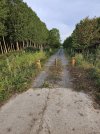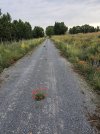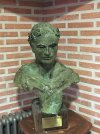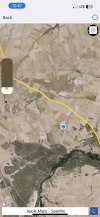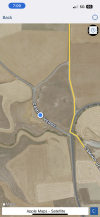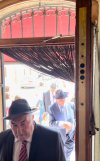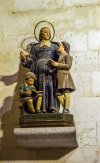Bachibouzouk
Active Member
- Time of past OR future Camino
- Voie de Soulac, Frances, De La Plata, Sureste/Levante, Manchego, Ruta del Argar.
Madrid - Colmenar Viejo
OK, I'm up and running. About 23 kms from Tres Olivos metro station to Colmenar Viejo today.
I arrived in Madrid a couple of days ago. Dropped my bag off at the hotel and walked from the iglesia Santiago y San Juan (open 12:00-19:30) to the cemetery in Fuencarral (12.5 kms?) with just a daypack. I saw not one waymark along the way. In truth I wasn't really looking very hard and had designed an itinerary of my own for some of the way to take me past the latest (and my third) iteration of the Santiago Bernabeu stadium. It looks resplendent and unconquerable in its Guggenheim-like metallic armour.
It would be possible to take the metro one stop further (Montecarmelo) but as that stop is only just across the motorway and requires a change of train, hardly worth it.
There wasn't much in terms of waymarking this morning either until the tunnel under the M40, after which the waymarking was excellent. The section to Tres Cantos was rather uninspiring, always within earshot, often within sight of the motorway and the railway line, sometimes in between the two. After Tres Cantos it got much better as the motorway and railway line, as well as the speeding cyclists, got left behind somewhere. Bright yellow gorse, vivid purple thistle, scarlet poppies, those electric blue flowers,.... along the trail. As I entered Campomar Viejo I saw my first stork atop the church, then dozens more on the parasol pines in the small park after the church and Ayuntamiento. What a magnificent sight to arrive to.
Great views over the surrounding countryside from the futuristic concrete and rusted iron bull ring that crowns the town.
I always try to remember to look over my shoulder when I walk, particularly when I leave a village, town or city. Looking back today was something of an anticlimax. For a capital city Madrid has a rather unprepossessing skyline. I know it's in a dip but most of the way it just looked like urban sprawl and a half dozen skyscrapers - until Colmenar Viejo, when at last it comes, rather modestly, into it's own.
Edit: In Colmenar Viejo I stayed in Hostal El Gran Chiscon, which for 43.00 euros with breakfast was a pretty decent deal.
OK, I'm up and running. About 23 kms from Tres Olivos metro station to Colmenar Viejo today.
I arrived in Madrid a couple of days ago. Dropped my bag off at the hotel and walked from the iglesia Santiago y San Juan (open 12:00-19:30) to the cemetery in Fuencarral (12.5 kms?) with just a daypack. I saw not one waymark along the way. In truth I wasn't really looking very hard and had designed an itinerary of my own for some of the way to take me past the latest (and my third) iteration of the Santiago Bernabeu stadium. It looks resplendent and unconquerable in its Guggenheim-like metallic armour.
It would be possible to take the metro one stop further (Montecarmelo) but as that stop is only just across the motorway and requires a change of train, hardly worth it.
There wasn't much in terms of waymarking this morning either until the tunnel under the M40, after which the waymarking was excellent. The section to Tres Cantos was rather uninspiring, always within earshot, often within sight of the motorway and the railway line, sometimes in between the two. After Tres Cantos it got much better as the motorway and railway line, as well as the speeding cyclists, got left behind somewhere. Bright yellow gorse, vivid purple thistle, scarlet poppies, those electric blue flowers,.... along the trail. As I entered Campomar Viejo I saw my first stork atop the church, then dozens more on the parasol pines in the small park after the church and Ayuntamiento. What a magnificent sight to arrive to.
Great views over the surrounding countryside from the futuristic concrete and rusted iron bull ring that crowns the town.
I always try to remember to look over my shoulder when I walk, particularly when I leave a village, town or city. Looking back today was something of an anticlimax. For a capital city Madrid has a rather unprepossessing skyline. I know it's in a dip but most of the way it just looked like urban sprawl and a half dozen skyscrapers - until Colmenar Viejo, when at last it comes, rather modestly, into it's own.
Edit: In Colmenar Viejo I stayed in Hostal El Gran Chiscon, which for 43.00 euros with breakfast was a pretty decent deal.
Last edited:












